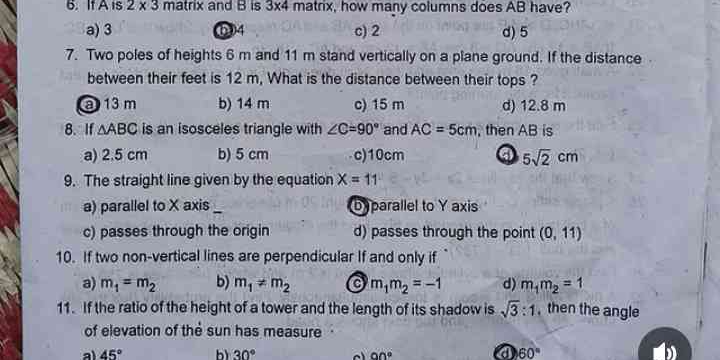If A is a 2 x 3 matrix and B is a 3 x 4 matrix, how many columns does AB have? Two poles of heights 6 m and 11 m stand vertically on a plane ground. If the distance between their f... If A is a 2 x 3 matrix and B is a 3 x 4 matrix, how many columns does AB have? Two poles of heights 6 m and 11 m stand vertically on a plane ground. If the distance between their feet is 12 m, what is the distance between their tops? If triangle ABC is an isosceles triangle with ∠C=90° and AC=5cm, then AB is? The straight line given by the equation x=11 is parallel to which axis? If two non-vertical lines are perpendicular if and only if m1=m2, m1=m2, m1m2=-1? If the ratio of the height of a tower and the length of its shadow is √3:1, then the angle of elevation of the sun has measure?

Understand the Problem
The question is providing mathematical problems related to matrices, geometry, and trigonometry, asking for various solutions based on the given scenarios.
Answer
1. 4 2. 13 3. $5\sqrt{2}$ 4. Parallel to Y-axis 5. $m_1 m_2 = -1$ 6. $60^\circ$
Answer for screen readers
- 4 (columns in $AB$)
- 13 m (distance between tops)
- $5\sqrt{2}$ cm (length of AB)
- Parallel to Y-axis (line from $X = 11$)
- $m_1 m_2 = -1$ (condition for perpendicular lines)
- $60^\circ$ (angle of elevation)
Steps to Solve
-
Understanding Matrix Multiplication To find the number of columns in the matrix product $AB$, we need to know the dimensions of both matrices. Matrix $A$ is $2 \times 3$ (2 rows and 3 columns) and matrix $B$ is $3 \times 4$ (3 rows and 4 columns).
-
Determining the Resulting Matrix Dimensions The number of columns in the resulting matrix $AB$ equals the number of columns in matrix $B$. Therefore, $AB$ will have:
- Rows from $A$: 2
- Columns from $B$: 4
-
Finding the Distance Between the Tops of Poles Using the Pythagorean theorem for two poles of heights 6 m and 11 m and base distance of 12 m, the height difference is: $$ h = 11 - 6 = 5 \text{ m} $$ The distance between the tops is calculated as: $$ d = \sqrt{(12)^2 + (5)^2} = \sqrt{144 + 25} = \sqrt{169} = 13 \text{ m} $$
-
Finding the Length of Side AB in Triangle ABC Given an isosceles triangle where $C = 90^\circ$, $AC = 5 \text{ cm}$, we apply Pythagorean theorem: $$ AB = \sqrt{AC^2 + BC^2} = \sqrt{5^2 + 5^2} = \sqrt{25 + 25} = \sqrt{50} = 5\sqrt{2} \text{ cm} $$
-
Identifying Lines from Their Equation The equation $X = 11$ represents a vertical line. Therefore, it is:
- Parallel to Y-axis.
-
Checking the Condition for Perpendicular Lines For two non-vertical lines to be perpendicular, the product of their slopes must equal $-1$, i.e., $m_1m_2 = -1$.
-
Calculating the Angle of Elevation of the Sun Given the ratio of height $h$ of the tower to the length of shadow $l$ as $\frac{h}{l} = \sqrt{3}$, we use the tangent for elevation angle: $$ \tan(\theta) = \frac{h}{l} \Rightarrow \theta = 60^\circ $$
- 4 (columns in $AB$)
- 13 m (distance between tops)
- $5\sqrt{2}$ cm (length of AB)
- Parallel to Y-axis (line from $X = 11$)
- $m_1 m_2 = -1$ (condition for perpendicular lines)
- $60^\circ$ (angle of elevation)
More Information
The answers cover fundamental concepts in matrices, geometry, and trigonometry, including Pythagorean theorem applications, properties of triangles, and understanding lines in coordinate geometry. The angle of elevation problem is common in trigonometry, relating ratios of a triangle's sides to angles.
Tips
- Confusing the dimensions of matrices when multiplying, which may lead to incorrect conclusions.
- Misapplying the Pythagorean theorem by not aligning the correct values (e.g., forgetting or miscalculating height differences).
- Not identifying the characteristics of lines correctly from equations.
AI-generated content may contain errors. Please verify critical information